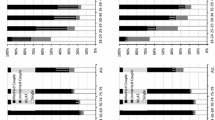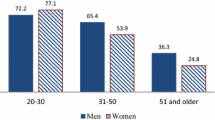Abstract
The increased variability in family types and forms of relationships is the most apparent outcome of family change in recent decades in Europe. One relationship that has emerged and recently become more visible, both in society and in science, is a ‘nonresidential partnership’ termed living apart together (LAT). We explore the meaning and incidence of LAT partnerships across Europe using a life course perspective. Cluster analysis using five cluster variables (living independently from parents, never having lived as a couple before, the intention to cohabit in the future, the age of the respondents, and the duration of the relationship) was carried out on data from the Generations and Gender Survey for ten countries. Four types of non-residential partnership across Europe are revealed. From a measurement perspective, a simplified model provides empirical evidence that three indicators are sufficient to detect and situate LAT relationships on a partnership continuum: (1) having a nonresidential partner, (2) the age of the respondent, and (3) the duration of the LAT relationship. Classifying relationships with a non-resident partner can be carried out efficiently if information about the age of the respondent and the duration of the current LAT relationship is available.

Similar content being viewed by others
References
Aldenderfer, M. S., & Blashfield, R. K. (1984). Cluster analysis. Thousand Oaks: Sage.
Barlow, A., & James, G. (2004). Regulating marriage and cohabitation in 21st century Britain. The Modern Law Review, 67(2), 143–176. doi:10.1111/j.1468-2230.2004.00482.x.
Bauman, Z. (2002). Foreword: Individually, together. In U. Beck & E. Beck-Gernsheim (Eds.), Individualization. Institutionalized individualism and its social and political consequences (pp. XIV–XIX). London: Sage.
Beaujouan, E., Regnier-Loilier, A., & Villeneueve-Gokalp, C. (2009). Neither single, nor in a couple: A study of living apart together in France. Demographic Research, 21(4), 75–108. doi:10.4054/demres.2009.21.4.
Bernardi, L., & Oppo, A. (2009). Living apart together at parents home (LATAP): A mediterranean route to adulthood. XXVI IUSSP international population conference: Marrakesh.
Borell, K., & Ghazanfareeon Karlsson, S. (2003). Reconceptualizing intimacy and ageing. Living apart together. In S. Arber, K. Davidson, & J. Ginn (Eds.), Gender and ageing: Changing roles and relationships. Buckingham: Open University Press.
Castro-Martín, T., Domínguez-Folgueras, M., & Martín-García, T. (2008). Not truly partnerless: Non-residential partnerships and retreat from marriage in Spain. Demographic Research, 18(16), 436–468. doi:10.4054/DemRes.2008.18.16.
Cherlin, A. J. (1978). Remarriage as an incomplete institution. American Journal of Sociology, 84(3), 634–650. doi:10.1086/226830.
De Graaf, A., & Loozen, S. (2004). Bijna 400 duizend personen kiezen voor een lat-relatie. In CBS (Ed.), Bevolkingstrends jaargang 52 (pp. 60–63). Heerlen/Voorburg: CBS.
de Gierveld, J. (2004a). The dilemma of repartnering: Considerations of older men and women entering new initimate relationships in later life. In K. Davidson & G. Fennell (Eds.), Intimacy in later life (pp. 85–103). New Brunswick: Transaction Publishers.
de Gierveld, J. (2004b). Remarriage, unmarried cohabitation, living apart together: Partner relationships following bereavement or divorce. Journal of Marriage and Family, 66(1), 236–243. doi:10.1111/j.0022-2445.2004.00015.x.
de Gierveld, J., & Latten, J. (2008). Incidentie en Achtergronden van Transitionele en Duurzame Latrelaties. Bevolkingstrends, 3, 29–38.
Duncan, S., & Phillips, M. (2010). People who live apart together (LATs)—How different are they? The Sociological Review, 58(1), 112–134. doi:10.1111/j.1467-954x.2009.01874.x.
Elder, G. H. J., Johnson, M. K., & Crosoe, R. (2004). The emergence and development of life course theory. In J. T. Mortimer & M. J. Shanahan (Eds.), Handbook of the lifecourse (pp. 3–19). New York: Springer.
Elder, G. H. J., & O’Rand, A. M. (1995). Adult lives in a changing society. In K. Cook, G. A. Fine, & J. S. House (Eds.), Sociological perspectives on social psychology (pp. 452–475). Boston: Allen and Unwin.
Ermisch, J., & Siedler, T. (2009). Living apart together. In J. Ermisch & M. Brynin (Eds.), Changing relationships. London: Routledge.
Everitt, B. S. (1993). Cluster analysis (3rd ed.). London: Halsted Press.
Ghazanfareeon Karlsson, S., & Borell, K. (2002). Intimacy and autonomy, gender and ageing. Ageing International, 27(4), 11–27. doi:10.1007/s12126-002-1012-2.
Ghazanfareeon Karlsson, S., & Borell, K. (2005). A home of their own. Women’s boundary work in LAT-relationships. Journal of Aging Studies, 19(1), 73–84. doi:10.1016/j.jaging.2004.03.008.
Gecas, V. (2003). Self-agency and the life course. In J. Mortimer & M. J. Shanahan (Eds.), Handbook of the life course (pp. 369–388). Berlin: Springer.
Giddens, A. (1992). The transformation of intimacy: Sexuality, love and eroticism in modern societies. Cambridge: Blackwell Publishers Ltd.
Hagestad, G. O. (1990). Social perspectives on the life course. In R. H. Binstock & A. L. George (Eds.), Handbook of aging and the social sciences (pp. 151–168). New York: Academic Press.
Hagestad, G. O. (2003). Interdependent lives and relationships in changing times: A life-course of families and aging. In R. A. Settersten Jr (Ed.), Invitation to the life course: Towards new understandings of later life (pp. 135–159). Amityville, NY: Baywood Publishing Company.
Hagestad, G. O., & Neugarten, B. L. (1985). Age and the life course. In E. Shanas & R. Binstock (Eds.), Handbook of aging and the social sciences (2nd ed., pp. 36–61). New York: Russell Sage Foundation.
Haskey, J. (2005). Living arrangements in contemporary Britain: Having a partner who usually lives elsewhere and living apart together (LAT). Population Trends, 122, 35–45.
Haskey, J., & Lewis, J. (2006). Living-apart-together in Britain: Context and meaning. International Journal of Law in Context, 2(1), 37–48. doi:10.1017/S1744552306001030.
Kaufman, L., & Rousseeuw, P. (1990). Finding Groups in data: An introduction to cluster analysis. New York: Wiley.
Levin, I. (2004). Living apart together: A new family form. Current Sociology, 52(2), 223–240. doi:10.1177/0011392104041809.
Levin, I., & Trost, J. (1999). Living apart together. Community, Work and Family, 2(3), 279–294. doi:10.1080/13668809908412186.
Liefbroer, A. C., Poortman, A. R., & Seltzer, J. A. (2015). Why do intimate partners live apart? Evidence on LAT relationships across Europe. Demographic Research, 32(251–286), 2015. doi:10.4054/DemRes..32.8.
Lodewijckx, E., & Deboosere, P. (2011). Huishoudens en families: Stabiliteit en snelle veranderingen gaan hand in hand. GGP Belgium Paper Series, 6, 31.
Lyssens-Danneboom, V., Eggermont, S., & Mortelmans, D. (2013). Living apart together (LAT) and law: Exploring legal expectations among LAT individuals in Belgium. Social and Legal Studies, 22(3), 357–376. doi:10.1177/0964663913478960.
Milan, A., & Peters, A. (2003). Couples living apart. Canadian Social Trends, Summer, 2–6.
Regnier-Loilier, A., Beaujouan, E., & Villeneuve-Gokalp, C. (2009). Neither single, nor in a couple. A study of living apart together in France. Demographic Research, 21(4), 75–108. doi:10.4054/demres.2009.21.4.
Reimondos, A., Evans, A., & Gray, E. (2011). Living-apart-together (LAT) relationships in Australia: An overview. Family Matters, 87, 43–55.
Roseneil, S. (2006). On not living with a partner: Unpicking coupledom and cohabitation. Sociological Research Online, 11(3), 1–14.
Schneider, N. F. (1996). Partnerschaften mit getrennten haushalten in den neuen und alten Bundesländern. In W. Bien (Ed.), Familie an der schwelle zum neuen jahrtausend (pp. 88–97): Leske & Budrich.
Settersten, R. A, Jr. (2003). Age structuring and the rhythm of the life course. In J. T. Mortimer & M. J. Shanahan (Eds.), Handbook of the life course (pp. 81–98). New York: Kluwer Academic/Plenum Publishers.
Skinner, D. A., & Kohler, J. K. (2002). Parental rights in diverse family contexts: Current legal developments. Family Relations, 51(4), 293–300. doi:10.1111/j.1741-3729.2002.00293.x.
Strohm, C. Q., Seltzer, J. A., Cochran, S. D., & Mays, V. M. (2009). Living apart together relationships in the United States. Demographic Research, 21(7), 177–214. doi:10.4054/demres.2009.21.7.
Author information
Authors and Affiliations
Corresponding author
Rights and permissions
About this article
Cite this article
Pasteels, I., Lyssens-Danneboom, V. & Mortelmans, D. A Life Course Perspective on Living Apart Together: Meaning and Incidence Across Europe. Soc Indic Res 130, 799–817 (2017). https://doi.org/10.1007/s11205-015-1189-x
Accepted:
Published:
Issue Date:
DOI: https://doi.org/10.1007/s11205-015-1189-x




